化学工程专业英语课文翻译
- 格式:doc
- 大小:117.50 KB
- 文档页数:24
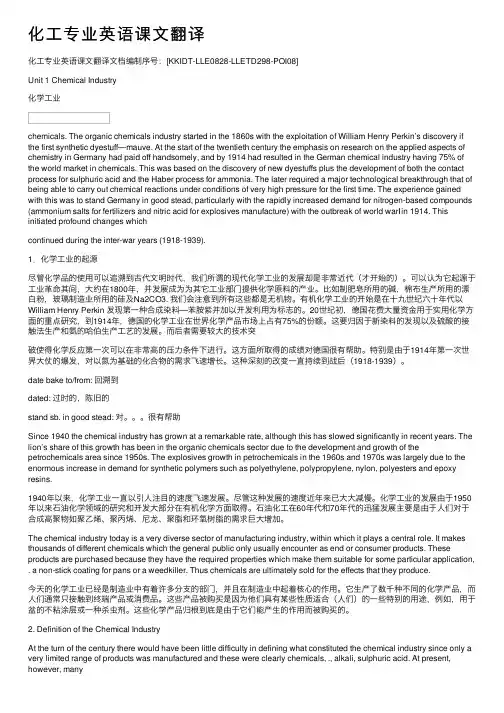
化⼯专业英语课⽂翻译化⼯专业英语课⽂翻译⽂档编制序号:[KKIDT-LLE0828-LLETD298-POI08]Unit 1 Chemical Industry化学⼯业chemicals. The organic chemicals industry started in the 1860s with the exploitation of William Henry Perkin’s discovery if the first synthetic dyestuff—mauve. At the start of the twentieth century the emphasis on research on the applied aspects of chemistry in Germany had paid off handsomely, and by 1914 had resulted in the German chemical industry having 75% of the world market in chemicals. This was based on the discovery of new dyestuffs plus the development of both the contact process for sulphuric acid and the Haber process for ammonia. The later required a major technological breakthrough that of being able to carry out chemical reactions under conditions of very high pressure for the first time. The experience gained with this was to stand Germany in good stead, particularly with the rapidly increased demand for nitrogen-based compounds (ammonium salts for fertilizers and nitric acid for explosives manufacture) with the outbreak of world warⅠin 1914. This initiated profound changes whichcontinued during the inter-war years (1918-1939).1.化学⼯业的起源尽管化学品的使⽤可以追溯到古代⽂明时代,我们所谓的现代化学⼯业的发展却是⾮常近代(才开始的)。
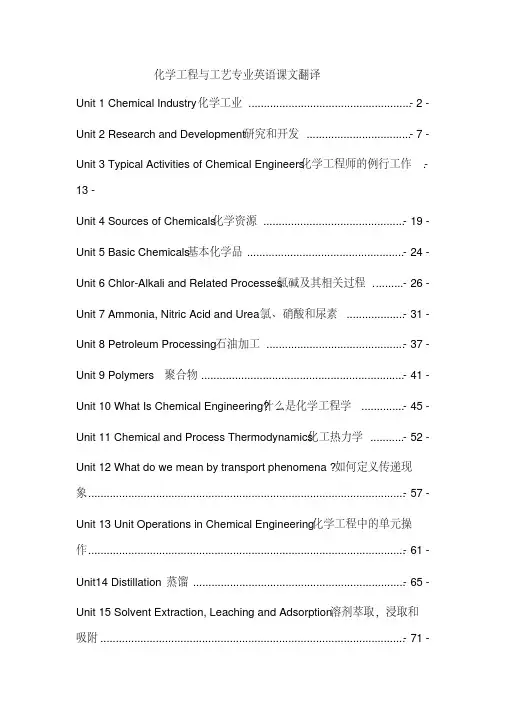
化学工程与工艺专业英语课文翻译Unit 1 Chemical Industry化学工业 ..................................................... - 2 - Unit 2 Research and Development研究和开发 .................................. - 7 - Unit 3 Typical Activities of Chemical Engineers化学工程师的例行工作 . -13 -
Unit 4 Sources of Chemicals化学资源 .............................................. - 19 - Unit 5 Basic Chemicals基本化学品................................................... - 24 - Unit 6 Chlor-Alkali and Related Processes氯碱及其相关过程.......... - 26 - Unit 7 Ammonia, Nitric Acid and Urea氯、硝酸和尿素 ................... - 31 - Unit 8 Petroleum Processing石油加工 ............................................. - 37 - Unit 9 Polymers 聚合物.................................................................. - 41 - Unit 10 What Is Chemical Engineering?什么是化学工程学 .............. - 45 - Unit 11 Chemical and Process Thermodynamics化工热力学 ........... - 52 - Unit 12 What do we mean by transport phenomena ?如何定义传递现象....................................................................................................... - 57 -
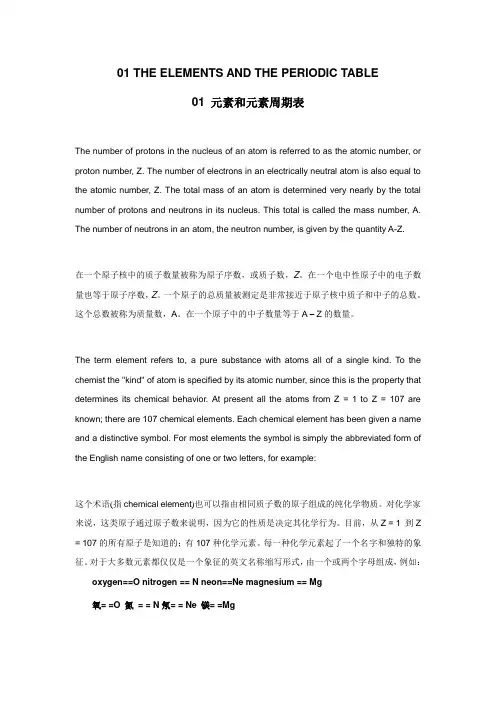
01 THE ELEMENTS AND THE PERIODIC TABLE01 元素和元素周期表The number of protons in the nucleus of an atom is referred to as the atomic number, or proton number, Z. The number of electrons in an electrically neutral atom is also equal to the atomic number, Z. The total mass of an atom is determined very nearly by the total number of protons and neutrons in its nucleus. This total is called the mass number, A. The number of neutrons in an atom, the neutron number, is given by the quantity A-Z.在一个原子核中的质子数量被称为原子序数,或质子数,Z。
在一个电中性原子中的电子数量也等于原子序数,Z。
一个原子的总质量被测定是非常接近于原子核中质子和中子的总数。
这个总数被称为质量数,A。
在一个原子中的中子数量等于A – Z的数量。
The term element refers to, a pure substance with atoms all of a single kind. To the chemist the "kind" of atom is specified by its atomic number, since this is the property that determines its chemical behavior. At present all the atoms from Z = 1 to Z = 107 are known; there are 107 chemical elements. Each chemical element has been given a name and a distinctive symbol. For most elements the symbol is simply the abbreviated form of the English name consisting of one or two letters, for example:这个术语(指chemical element)也可以指由相同质子数的原子组成的纯化学物质。
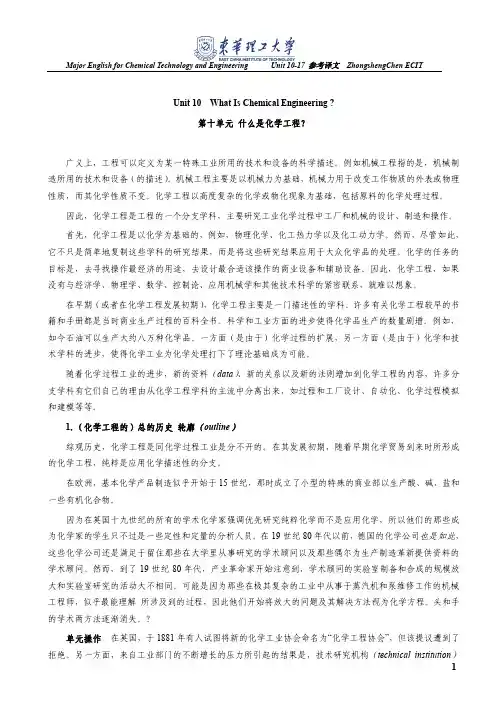
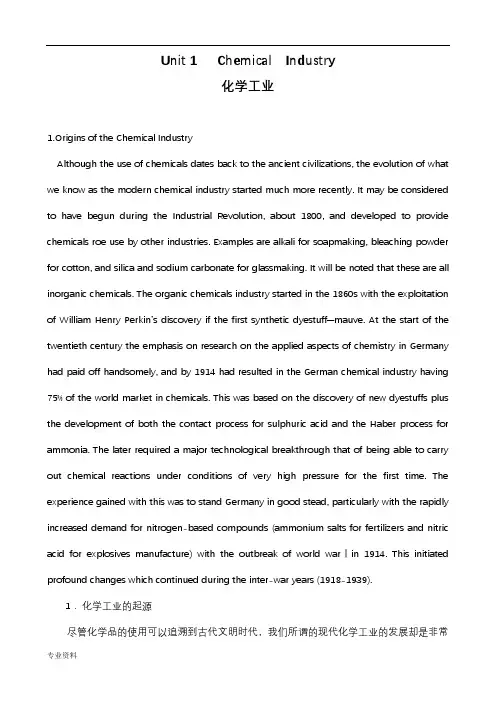
Unit 1 Chemical Industry化学工业1.Origins of the Chemical IndustryAlthough the use of chemicals dates back to the ancient civilizations, the evolution of what we know as the modern chemical industry started much more recently. It may be considered to have begun during the Industrial Revolution, about 1800, and developed to provide chemicals roe use by other industries. Examples are alkali for soapmaking, bleaching powder for cotton, and silica and sodium carbonate for glassmaking. It will be noted that these are all inorganic chemicals. The organic chemicals industry started in the 1860s with the exploitation of William Henry Perkin’s discovery if the first synthetic dyestuff—mauve. At the start of the twentieth century the emphasis on research on the applied aspects of chemistry in Germany had paid off handsomely, and by 1914 had resulted in the German chemical industry having 75% of the world market in chemicals. This was based on the discovery of new dyestuffs plus the development of both the contact process for sulphuric acid and the Haber process for ammonia. The later required a major technological breakthrough that of being able to carry out chemical reactions under conditions of very high pressure for the first time. The experience gained with this was to stand Germany in good stead, particularly with the rapidly increased demand for nitrogen-based compounds (ammonium salts for fertilizers and nitric acid for explosives manufacture) with the outbreak of world warⅠin 1914. This initiated profound changes which continued during the inter-war years (1918-1939).1.化学工业的起源尽管化学品的使用可以追溯到古代文明时代,我们所谓的现代化学工业的发展却是非常近代(才开始的)。
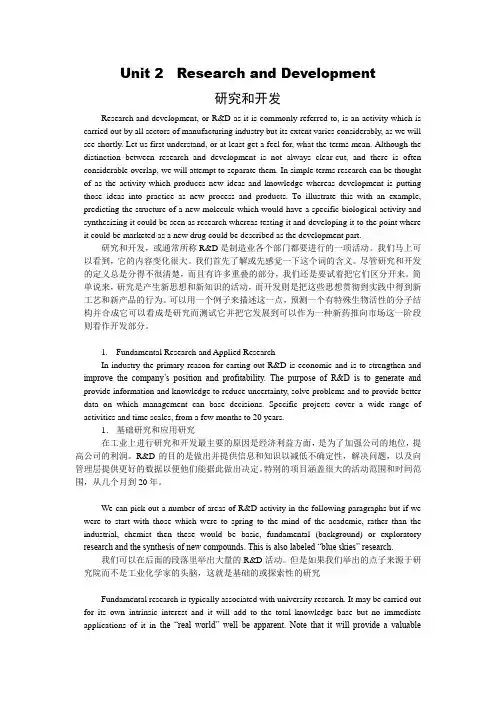
Unit 2 Research and Development研究和开发Research and development, or R&D as it is commonly referred to, is an activity which is carried out by all sectors of manufacturing industry but its extent varies considerably, as we will see shortly. Let us first understand, or at least get a feel for, what the terms mean. Although the distinction between research and development is not always clear-cut, and there is often considerable overlap, we will attempt to separate them. In simple terms research can be thought of as the activity which produces new ideas and knowledge whereas development is putting those ideas into practice as new process and products. To illustrate this with an example, predicting the structure of a new molecule which would have a specific biological activity and synthesizing it could be seen as research whereas testing it and developing it to the point where it could be marketed as a new drug could be described as the development part.研究和开发,或通常所称R&D是制造业各个部门都要进行的一项活动。
![[2021年考研]《化学工程与工艺专业英语》课文翻译](https://uimg.taocdn.com/a4bf851f3b3567ec112d8a3d.webp)
Unit 1 Chemical Industry1.Origins of the Chemical IndustryAlthough the use of chemicals dates back to the ancient civilizations, the evolution of what we know as the modern chemical industry started much more recently. It may be considered to have begun during the Industrial Revolution, about 1800, and developed to provide chemicals roe use by other industries. Examples are alkali for soapmaking, bleaching powder for cotton, and silica and sodium carbonate for glassmaking. It will be noted that these are all inorganic chemicals. The organic chemicals industry started in the 1860s with the exploitation of William Henry Perkin’s discovery if the first synthetic dyestuff—mauve. At the start of the twentieth century the emphasis on research on the applied aspects of chemistry in Germany had paid off handsomely, and by 1914 had resulted in the German chemical industry having 75% of the world market in chemicals. This was based on the discovery of new dyestuffs plus the development of both the contact process for sulphuric acid and the Haber process for ammonia. The later required a major technological breakthrough that of being able to carry out chemical reactions under conditions of very high pressure for the first time. The experience gained with this was to stand Germany in good stead, particularly with the rapidly increased demand for nitrogen-based compounds (ammonium salts for fertilizers and nitric acid for explosives manufacture) with the outbreak of world warⅠin 1914. This initiated profound changes which continued during the inter-war years (1918-1939).1.化学工业的起源尽管化学品的使用可以追溯到古代文明时代,我们所谓的现代化学工业的发展却是非常近代(才开始的)。
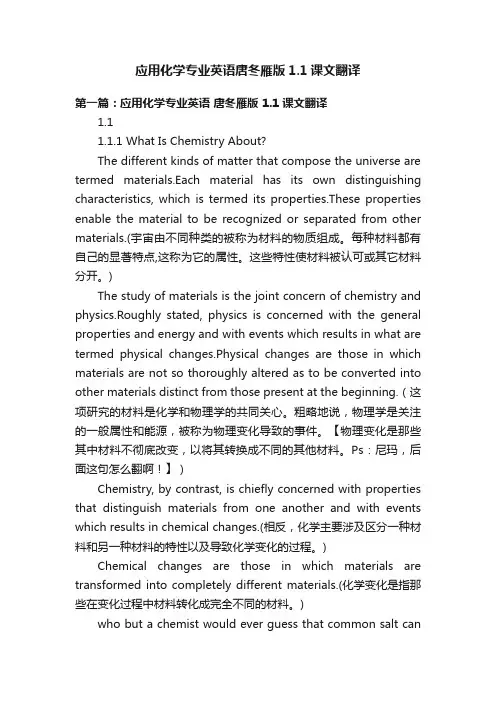
应用化学专业英语唐冬雁版1.1课文翻译第一篇:应用化学专业英语唐冬雁版 1.1 课文翻译1.11.1.1 What Is Chemistry About?The different kinds of matter that compose the universe are termed materials.Each material has its own distinguishing characteristics, which is termed its properties.These properties enable the material to be recognized or separated from other materials.(宇宙由不同种类的被称为材料的物质组成。
每种材料都有自己的显著特点,这称为它的属性。
这些特性使材料被认可或其它材料分开。
)The study of materials is the joint concern of chemistry and physics.Roughly stated, physics is concerned with the general properties and energy and with events which results in what are termed physical changes.Physical changes are those in which materials are not so thoroughly altered as to be converted into other materials distinct from those present at the beginning.(这项研究的材料是化学和物理学的共同关心。
粗略地说,物理学是关注的一般属性和能源,被称为物理变化导致的事件。
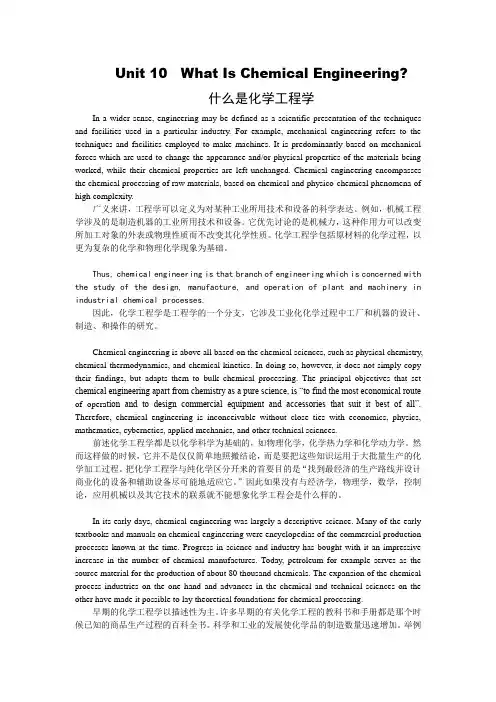
Unit 10 What Is Chemical Engineering?什么是化学工程学In a wider sense, engineering may be defined as a scientific presentation of the techniques and facilities used in a particular industry. For example, mechanical engineering refers to the techniques and facilities employed to make machines. It is predominantly based on mechanical forces which are used to change the appearance and/or physical properties of the materials being worked, while their chemical properties are left unchanged. Chemical engineering encompasses the chemical processing of raw materials, based on chemical and physico-chemical phenomena of high complexity.广义来讲,工程学可以定义为对某种工业所用技术和设备的科学表达。
例如,机械工程学涉及的是制造机器的工业所用技术和设备。
它优先讨论的是机械力,这种作用力可以改变所加工对象的外表或物理性质而不改变其化学性质。
化学工程学包括原材料的化学过程,以更为复杂的化学和物理化学现象为基础。
Thus, chemical engineering is that branch of engineering which is concerned with the study of the design, manufacture, and operation of plant and machinery in industrial chemical processes.因此,化学工程学是工程学的一个分支,它涉及工业化化学过程中工厂和机器的设计、制造、和操作的研究。
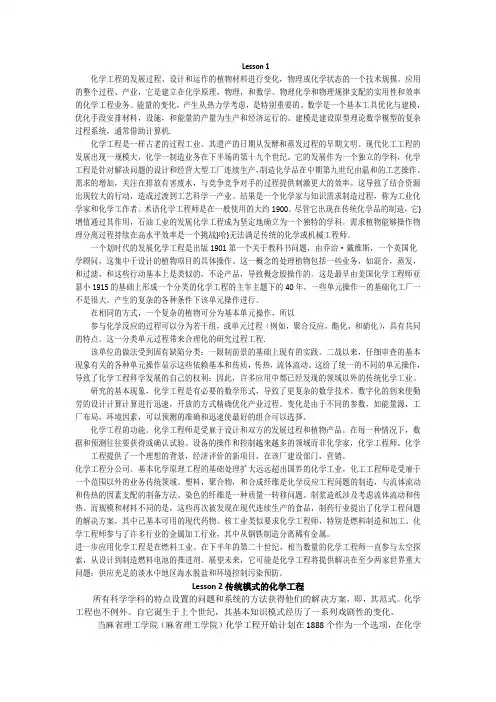
Lesson 1 化学工程的发展过程、设计和运作的植物材料进行变化,物理或化学状态的一个技术规模。应用的整个过程、产业,它是建立在化学原理,物理,和数学。物理化学和物理规律支配的实用性和效率的化学工程业务。能量的变化,产生从热力学考虑,是特别重要的。数学是一个基本工具优化与建模,优化手段安排材料,设施,和能量的产量为生产和经济运行的。建模是建设原型理论数学模型的复杂过程系统,通常借助计算机. 化学工程是一样古老的过程工业。其遗产的日期从发酵和蒸发过程的早期文明。现代化工工程的发展出现一规模大,化学一制造业务在下半场的第十九个世纪。它的发展作为一个独立的学科,化学工程是针对解决问题的设计和经营大型工厂连续生产,制造化学品在中期第九世纪由温和的工艺操作。需求的增加,关注在排放有害废水,与竞争竞争对手的过程提供刺激更大的效率。这导致了结合资源出现较大的行动,造成过渡到工艺科学一产业。结果是一个化学家与知识需求制造过程,称为工业化学家和化学工作者。术语化学工程师是在一般使用的大约1900。尽管它出现在传统化学品的制造,它}增值通过其作用,石油工业的发展化学工程成为坚定地确立为一个独特的学科。需求植物能够操作物理分离过程持续在高水平效率是一个挑战}哈}无法满足传统的化学或机械工程师。 一个划时代的发展化学工程是出版1901第一个关于教科书问题,由乔治·戴维斯,一个英国化学顾问,这集中于设计的植物项目的具体操作。这一概念的处理植物包括一些业务,如混合,蒸发,和过滤,和这些行动基本上是类似的,不论产品,导致概念股操作的。这是最早由美国化学工程师亚瑟小1915的基础上形成一个分类的化学工程的主宰主题下的40年。一些单元操作一的基础化工厂一不是很大。产生的复杂的各种条件下该单元操作进行。 在相同的方式,一个复杂的植物可分为基本单元操作,所以 参与化学反应的过程可以分为若干组,或单元过程(例如,聚合反应,酯化,和硝化),具有共同的特点。这一分类单元过程带来合理化的研究过程工程. 该单位的做法受到固有缺陷分类:一限制前景的基础上现有的实践。二战以来,仔细审查的基本现象有关的各种单元操作显示这些依赖基本和传质,传热,流体流动。这给了统一的不同的单元操作,导致了化学工程科学发展的自己的权利;因此,许多应用中都已经发现的领域以外的传统化学工业。 研究的基本现象,化学工程是有必要的数学形式,导致了更复杂的数学技术。数字化的到来使勤劳的设计计算计算进行迅速,开放的方式精确优化产业过程。变化是由于不同的参数,如能量源,工厂布局,环境因素,可以预测的准确和迅速使最好的组合可以选择。 化学工程的功能。化学工程师是受雇于设计和双方的发展过程和植物产品。在每一种情况下,数据和预测往往要获得或确认试验。设备的操作和控制越来越多的领域而非化学家,化学工程师。化学 工程提供了一个理想的背景,经济评价的新项目,在该厂建设部门,营销。 化学工程分公司。基本化学原理工程的基础处理扩大远远超出国界的化学工业,化工工程师是受雇于一个范围以外的业务传统领域。塑料,聚合物,和合成纤维是化学反应工程问题的制造,与流体流动和传热的因素支配的制备方法。染色的纤维是一种质量一转移问题。制浆造纸涉及考虑流体流动和传热。而规模和材料不同的是,这些再次被发现在现代连续生产的食品,制药行业提出了化学工程问题的解决方案,其中已基本可用的现代药物。核工业类似要求化学工程师,特别是燃料制造和加工。化学工程师参与了许多行业的金属加工行业,其中从钢铁制造分离稀有金属。 进一步应用化学工程是在燃料工业。在下半年的第二十世纪,相当数量的化学工程师一直参与太空探索,从设计到制造燃料电池的推进剂。展望未来,它可能是化学工程将提供解决在至少两家世界重大问题:供应充足的淡水中地区海水脱盐和环境控制污染预防。 Lesson 2传统模式的化学工程 所有科学学科的特点设置的问题和系统的方法获得他们的解决方案,即,其范式。化学工程也不例外。自它诞生于上个世纪,其基本知识模式经历了一系列戏剧性的变化。 当麻省理工学院(麻省理工学院)化学工程开始计划在1888个作为一个选项,在化学 系的课程,主要描述工业业务和组织的具体产品。缺乏一个范式一些变得明显。一个更好的知识基础知识是因为需要从一个化学工业往往是不同的细节,从其他行业,如化学硫酸是非常不同,润滑油。 第一范式为化学工程学科的基础是统一的概念“单元操作”提出的亚瑟·小1915。它演变惯性响应需要大规模制造的商品经济的概念股。经营中所持有的任何化学制造过程可以分解成一个协调一系列的操作如粉碎,干燥,焙烧,结晶,过滤,蒸发, 蒸馏,电解,等等。因此,例如,学术研究的具体松节油制造方面可以代替遗传研究蒸馏,一过程中常见的许多其他行业。一个单元操作概念的定量形式出现了大约1924,只是在时间为第一次石油危机由于迅速增长汽车的数量。化学工程师的能力的定量表征单元操作使得合理设计的第一个现代炼油厂。第一个繁荣的就业化学工程师的石油工业是。 在这一时期的密集发展单位经营,其他经典工具化学工程分析的介绍或广泛发展。这些 包括研究过程中材料和能量平衡的基础多组分系统的热力学研究。 二战后,逐渐枯竭的问题传统的单元研究经营被视。这导致另一个范式的化学工程,首创的工程科学运动。满意实证描述工艺设备性能,化学工程师开始重新审视单元操作 一个更根本的角度。这种现象发生在单元操作分解到分子事件。定量机理模型对这些事件 开发和利用,分析现有的设备,以及设计新的工艺设备。数学模型的过程和反应器的开发和应用资本密集型产业一商品等石化产品。 Lesson 3单元操作 化学工程已做的工业过程中,原材料改变或分离成有用的产品。化学工程师必须开发,设计,和工程师完成工艺和设备的使用;选择合适的原材料;经营植物的高效,安全,经济;确保产品符合按客户要求。化学工程是一门艺术和科学。当科学可以帮助工程师解决问题,科学应该用。当,像是通常情况下,科学并没有给一个完整的答案,有必要使用经验 与判断。专业地位取决于技能的工程师利用所有来源信息处理桃实际解决问题。 范围和各种进程和产业,称为服务化工工程师都是伟大的。这个字段不是一个容易定义。过程描述标准论文化学工艺和技术行业提供最好的想法的化学工程领域。 因品种和复杂的现代进程,这是不可行的盖所有的化工领域下的一个单头。棒球场分为 方便,但任意,部门。 这个文本涵盖化学工程部分已知为单位的行动。一个经济组织方法大部分题材的化学工程是基于以下两点:(1)虽然一些个人的过程是伟大的,每一个都可以分解成一系列步骤,称为操作,每一个又出现在后处理过程;(2)的操作都是基于技术和相同的科学原理。例如,在大多数过程要转移固体和液体,热或其他形式的能量必须从一个物体传递到另一个,和任务干燥,减小尺寸,蒸馏,和蒸发必须执行的单元操作。概念是这样的:通过系统的学习,这些行动本身一作业明确跨行业和生产线一治疗全过程的统一。 严格的化学方面的处理研究中的一个伴侣化工区 工程称为反应动力学。单元操作主要是用来进行主要的物质制备反应,分离和净化产品, 回收未反应物,和控制能量转移进或运出的化学反应器。 单元操作适用于许多物理过程和化学过程。例如,用于制造食盐含有下列顺序 单元操作:运输固体和液体,传热,蒸发,结晶,干燥,和筛选。没有化学反应出现在这些步骤。论另一方面,石油裂化,或不援助的催化剂,是一个典型的化学反应进行的一个规模巨大的。这里的单元操作一运输液体和固体,蒸馏,和各种机械分离一是至关重要的,和 裂化反应不能使用,没有他们。化学步骤本身通过控制物质和能量的流动和从反应区。 因为单元操作工程的一个分支,它们是基于科学和经验。理论与实践的结合产生设计设备可以制造,组装,操作,维护。一个平衡的讨论每个操作需要理论和设备一起考虑。大量的科学原理和技术的基本处理单元操作。一些基本物理和山楂等化学物质与能量守恒,物质 平衡,动力学,和某些物质的性质。他们一般使用描述},这个文本的剩余物。其他特殊技术重要的化学工程被认为是在适当的地方在文本。 5课 过滤 分离固体从液体中悬浮通过一个多孔介质或屏幕保留固体,允许液体支付称为过滤。 一般来说,介质的孔隙将大于粒子,是删除,和过滤器将有效地工作,只有在经过最初的存款已被困在中。在化学实验室,过滤是经常进行的一种形式,毕希纳funnelz,和液体是通过吸薄layex的粒子使用真空源:在简单的情况下暂停倒入锥形漏斗安装一个过滤器纸。在工业相当等操作,困难参与机械处理如此大量的悬浮固体。厚层的固体有形式,从而实现率高,通过液体通过固体高压力将是必要的,这将是有必要提供一个更大的地区的一个典型。过滤介质过滤操作显示,其支持和层的固体,或滤饼,这已经形成。 该卷的悬浮液是将不同的非常大的数量在净化水和矿在采矿业比较小批量的精细化工行业,各种固体会很大。在大多数情况下,在化学工业是固体,就需要和他们的身体尺寸和性能是至关重要的。因此主要考虑因素时选择设备和操作条件: 一)性能的液体,特别是其粘度,密度和腐蚀性能。 二)性质的固体一其颗粒大小和形状,大小分布,和包装特点。 三)浓度的悬浮固体。 四)的数量要处理的材料,及其价值。 五)是否有价值的产品是固体,液体,或两者。 六)清洗的固体过滤。 七)是否非常轻微污染造成的暂停或滤液各组成部分的设备是不利于产品。 八)是否会被加热的料液。 九)是否有任何形式的预处理将是有益的 过滤基本上是一个机械操作,要求较低的能量比蒸发或烘干而高潜在的热的液体,通常是水,有提供。在典型操作蛋糕逐步建立在介质和流动阻力逐渐增加。在初始时期东风流动,颗粒沉积在表面层布形成的过滤介质。这初始保证金可能是形成了从一个特殊的初始流量的预涂材料的最重要的因素。该过滤速度则取决于将: 一个)的压力下降从饲料到远侧的过滤介质。 乙)面积的过滤表面。 三)粘度滤液, 四)抵抗的过滤器蛋糕。 五)过滤介质的阻力和初始层蛋糕。 该过滤式上面所描述的是通常被称为ltration蛋糕的比例固体悬浮液中大,大部分粒子被收集在滤饼可随后脱离中的比例固体。很小,例如在空气或水过滤,颗粒往往会很大小于过滤介质的孔隙和渗透深度较大之前被抓获;这一过程被称为深床过滤的。在下一节课的类型过滤设备将被考虑。 lesson6 heart transfer热传导 几乎所有的行动所进行的化学工程师参与生产或吸收的能量以热的形式的管理和转让。热量和类型的装置,其主要目的是控制热流因此非常重要的。 当物体在不同温度下被带进接触热,热流量从对象在较高的温度,在较低的temperahire净流量。总是方向的温度下降。该机制,热可流程三:传导,对流,辐射。 传导 如果一个传导温度梯度存在于一个连续的物质,热流量没有任何看得见的物质运动。热流量的这种电缆传导。在金属固体热传导的结果,从运动约束电子,并有密切的对应关系和热导率传导的结果从动量输送的个别分子沿温度梯度。气体传导发生分子的随机运动,热是“扩散”从炎热地区寒冷的。最常见的例子传导热流量在不透明的固体,如在砖炉
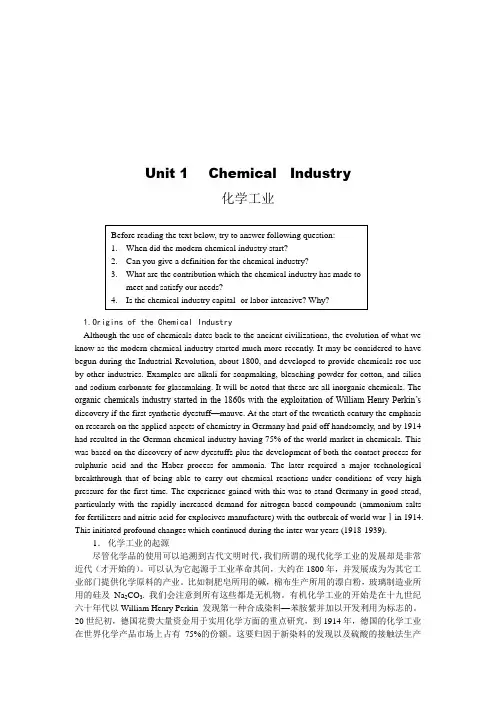
Unit 1 Chemical Industry化学工业1.Origins of the Chemical IndustryAlthough the use of chemicals dates back to the ancient civilizations, the evolution of what we know as the modern chemical industry started much more recently. It may be considered to have begun during the Industrial Revolution, about 1800, and developed to provide chemicals roe use by other industries. Examples are alkali for soapmaking, bleaching powder for cotton, and silica and sodium carbonate for glassmaking. It will be noted that these are all inorganic chemicals. The organic chemicals industry started in the 1860s with the exploitation of William Henry Perkin’s discovery if the first synthetic dyestuff—mauve. At the start of the twentieth century the emphasis on research on the applied aspects of chemistry in Germany had paid off handsomely, and by 1914 had resulted in the German chemical industry having 75% of the world market in chemicals. This was based on the discovery of new dyestuffs plus the development of both the contact process for sulphuric acid and the Haber process for ammonia. The later required a major technological breakthrough that of being able to carry out chemical reactions under conditions of very high pressure for the first time. The experience gained with this was to stand Germany in good stead, particularly with the rapidly increased demand for nitrogen-based compounds (ammonium salts for fertilizers and nitric acid for explosives manufacture) with the outbreak of world warⅠin 1914. This initiated profound changes which continued during the inter-war years (1918-1939).1.化学工业的起源尽管化学品的使用可以追溯到古代文明时代,我们所谓的现代化学工业的发展却是非常近代(才开始的)。
Unit1Chemical Industry
化学工业
1.Origins ofthe Chemical Industry
Althoughthe useof chemicals dates backtothe ancient civilizations, the evolutionof whatwe know as themodern chemical industry started much more recently. It may be considered to have begun during the IndustrialRevolution, about 1800, and developedto provide chemicalsroe use by other industries. Examples are alkali for soapmaking,bleaching powder for cotton,and silica andsodium carbonate forglassmaking. It will be noted thatthese areall inorganic chemicals. Theorganic chemicals industry startedin the1860s with theexploitationof WilliamHenry Perkin’sdiscover yif thefirst synthetic dyestuff—mauve. At thestart ofthe twen tiethcentury the emphasis on research on the applied aspects of chemistry in Germany had paidoff handsomely,andby 1914had resulted in the German chemicalindustryhaving75% ofthe worldmarketinche micals.Thiswas basedon the discoveryof new dyestuffs plus the development of boththe contactprocess forsulphuric acid and theHaberprocess for ammonia.Thelater required a majortechnological breakthroughthat of being ableto carry outchemical reactions under conditionsof veryhigh pressure forthe firsttime.The experience gained withthis was tostand Germany ingood stead, particularly with the rapidly increased demandfor nitrogen-based compounds(ammonium salts forfertilizers andnitric acid for explosives manufacture)with theoutbreakof world warⅠin 1914. This initiated profound changeswhich continued duringthe inter-war years (1918-1939).
1.化学工业的起源
尽管化学品的使用可以追溯到古代文明时代,我们所谓的现代化学工业的发展却是非常
近代(才开始的)。
可以认为它起源于工业革命其间,大约在1800年,并发展成为为其它工业部门提供化学原料的产业。
比如制肥皂所用的碱,棉布生产所用的漂白粉,玻璃制造业所用的硅及Na2CO3.我们会注意到所有这些都是无机物。
有机化学工业的开始是在十九世纪六十年代以William Henry Perkin发现第一种合成染料—苯胺紫并加以开发利用为标志的。
20世纪初,德国花费大量资金用于实用化学方面的重点研究,到1914年,德国的化学工业在世界化学产品市场上占有75%的份额。
这要归因于新染料的发现以及硫酸的接触法生产和氨的哈伯生产工艺的发展。
而后者需要较大的技术突破使得化学反应第一次可以在非常高的压力条件下进行。
这方面所取得的成绩对德国很有帮助。
特别是由于1914年第一次世界大仗的爆发,对以氮为基础的化合物的需求飞速增长。
这种深刻的改变一直持续到战后(1918-1939)。
datebake to/from: 回溯到
dated: 过时的,陈旧的
standsb.in goodstead:对。
很有帮助
Since1940the chemical industry hasgrown at a remarkable rate,alt hough this has slowed significantlyinrecent years.Thelion’sshare o fthis growthhas been in the organic chemicalssector due tothedevelopment and growth ofthe petrochemicals areasince1950s.The explosives growthinpetrochemicals inthe1960s and1970s was largely due to the enormous increase in demandforsynthetic polymers suchaspolyethylene,polypropylene, nylon,polyesters and epoxy resins.
1940年以来,化学工业一直以引人注目的速度飞速发展。
尽管这种发展的速度近年来已大大减慢。
化学工业的发展由于1950年以来石油化学领域的研究和开发大部分在有机化学方面取得。
石油化工在60年代和70年代的迅猛发展主要是由于人们对于合成高聚物如聚乙烯、聚丙烯、尼龙、聚脂和环氧树脂的需求巨大增加。
Thechemicalindustrytoday is a very diversesectorof manufacturing industry,within which itplays a central role. Itmakesthou sandsof differentchemicals which the general publiconlyusually en counterasend or consumer products.These productsare purchased becausetheyhavethe required properties which make them suitable for some particular application, e.g. a non-stick coating forpans oraweedkiller.Thus chemicals are ultimately sold for the effects that they produce.
今天的化学工业已经是制造业中有着许多分支的部门,并且在制造业中起着核心的作用。
它生产了数千种不同的化学产品,而人们通常只接触到终端产品或消费品。
这些产品被购买是因为他们具有某些性质适合(人们)的一些特别的用途,例如,用于盆的不粘涂层或一种杀虫剂。
这些化学产品归根到底是由于它们能产生的作用而被购买的。
2. Definitionof the Chemical Industry
At the turnof the century there would have been little difficulty indefiningwhatconstitutedthechemical industry since onlyavery limited rangeofproducts was manufactured andthese wereclearly chemicals, e.g., alkali, sulphuricacid.At present,however,many intermediatestoproductsproduced, from raw materials like crude oil。